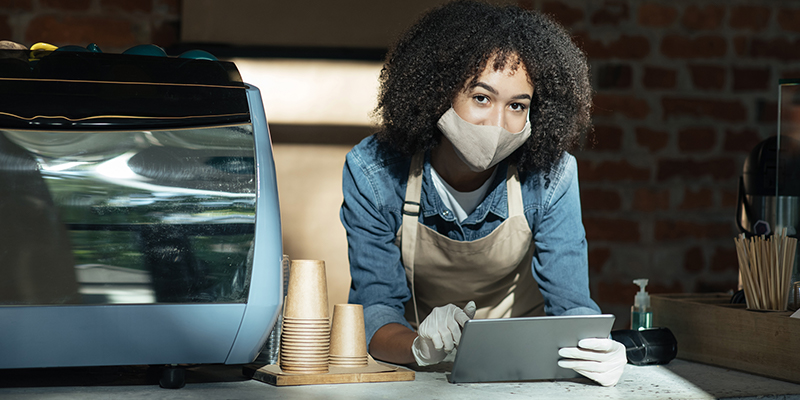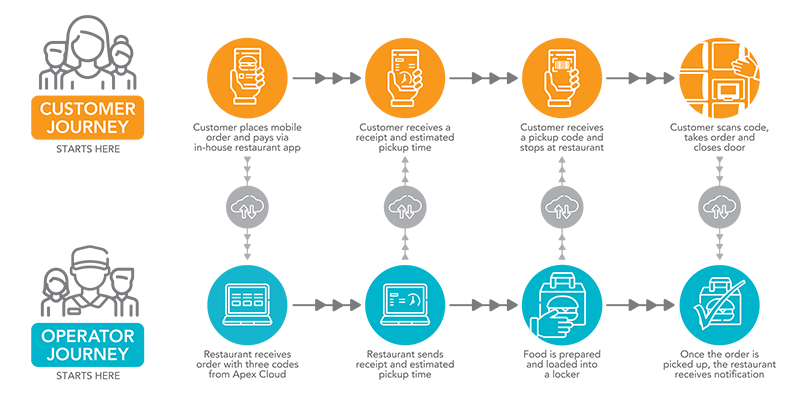
Better results start with changes in operations, behaviors, and the consumer experience
How to maximize food locker results
When most people think about smart food lockers, the first image that comes to mind is the physical locker – more restaurant equipment. That’s understandable, since the physical device is what you first see, touch and feel. Naturally, they think of food lockers as a simple restaurant equipment installation project.
That idea can be deceiving. It can lead you to think all you have to do is purchase a good pickup locker, plug it in, do a little bit of training, and you’re off and running, reaping lots of benefits along the way. In this way of thinking, the food locker is a dumb box that sits at the end of the food make line and plays a very limited role. When an order is finished, the order is loaded into the locker and then a customer comes and picks up the order. That’s basically the whole story. The benefits of this approach are minimal.
But, lockers can and ought to be smart. Successfully implementing a smart locker solution requires a different way of looking at your operation. To get the most from it, several key changes need to take place across your organization.
When it comes to implementing change, particularly in technology, it’s valuable to think more broadly about the task. This may help you achieve results that extend far beyond the original benefits you first envisioned.
Let’s look at how thinking more broadly about smart food lockers can deliver impressive results across an operation.
How an intelligent order pickup solution is different
There’s a lot more that can be accomplished with a smart food locker as opposed to the typical locker. Thinking more holistically, a smart food locker is an integrated digital component of a complete digital order fulfillment process. Yes, it requires equipment installation. But the software is as important, if not more so, as the physical device.
The software is what connects the locker to the rest of the kitchen processes, providing real opportunities for process redesign and efficiency gains. The software is also what delivers the data and metrics that allow brands to effectively manage and continuously improve the handling of off-premises orders all while optimizing the consumer experience.
This broader way of thinking about order pickup lockers serves to illustrate why adding smart food lockers to your operation is not just an equipment installation project (although it is that) but one that involves changes across the organization. The benefits—to customers, store associates, and the bottom line—are only achieved when real change in store operations, people’s behaviors and the consumer experience occur.
A closer look at the smart order pickup process
Here’s what that could look like. A smart food locker solution gives you many tools to achieve this vision, but process and people change must occur to make it a reality.
A customer places and pays for a takeout order on your digital app. The order is then passed to the store POS system to begin in-store processing. The POS system initiates three things:
- The order is passed to your kitchen management system to cue the preparation of the order
- The order is passed to your smart food locker solution to create the order in the system and to start the order create-to-load timer
- Because you’ve been getting good data/metrics and using it to achieve efficiency and consistency in your kitchen processes, you know how long it will take to prepare the order. So, an in-app message is immediately sent to the customer telling them the approximate time the order will be ready. For the most advanced brands, this messaging can be adjusted in real time based on kitchen and locker status to minimize customer wait times.
The order is then prepared. At the end of the make line, when the kitchen management system is told the order is complete, an in-app message is sent to the customer telling them their order is ready for pickup, and providing a QR code to open the compartment. Meanwhile, a store team member is frictionlessly loading it into the locker: they place it in a compartment, an in-compartment sensor recognizes that an item has been loaded, and then the team member touches “Complete” on the user interface. At the same time, the first team member begins to prep the next order. The moment the order is loaded, the order create-to-load timer is stopped, and the dwell-time indicator is started.
Then, the customer arrives, walks up to the food locker, scans the QR code, the door pops open, and the customer takes their order and leaves. The moment the compartment door is opened, the dwell-time timer is stopped.

Each step of the smart order pickup process provides data that helps operators get a more complete picture of their operation’s processes and their customer’s experience.
Valuable new order pickup data is revealed
Here’s where the benefits of the smart order pickup system really come into play. For that order (and every order across every store), the brand now has data that tells it:
- When it was received at the store
- When it was loaded into the locker
- The order create-to-load time
- When it was picked up and from what compartment
- The order dwell time
The brand knows this whether the order was picked up by a customer or a delivery driver. It can also track things like orders that were reclaimed or locked down due to exceeding the brand’s freshness time threshold.
To optimize all of this, key systems must be integrated. Just as importantly, there needs to be people and process changes, along with data/analytics to track, manage, and continuously improve off-premises order handling. As with any change, success is the result of careful planning, especially on the people side, and great execution.
Let’s dig in a little on each of these changes:
Integrated Systems
- The optimal environment includes a seamless digital connection from your branded app to your front- and back-of-house systems to your order pickup solution. This is the digital highway that keeps your customer in your branded app from beginning to end of the order transaction. It also connects your various back-of-house processes together to drive efficiency, and captures all the data on every transaction.
People and Processes
- Consumer – To really maximize your benefits, you want your customers to regularly spend time in your digital app and for the digital app to be their go-to for placing off-premises orders. In addition, your customers need to know that safe, simple, easy order pickup is available and to be comfortable using it. (This is similar for DSP drivers as well.) The brand needs to communicate and drive these changes.
- Store Associate – The bulk of the change happens here, as this is where the most people are involved. A smart food locker system immediately enables new processes such as order loading, re-claiming, and more. There is data available to be analyzed and used to help manage the off-premises order process. There are also process changes that occur over time as data is collected, analyzed, and improvements implemented. Most importantly, associates only touch the order once after it’s been assembled to load it in the locker.
Data and Analytics
- You now have data and metrics on your off-premises order process (similar to what you have for drive-thru.) You can manage the process and other participants, including DSPs, using data and metrics. You can also utilize analytics to gain insight to continuously improve both your back-of-house processes and the consumer experience. And, you have the same data for every store in your portfolio, allowing you to compare and contrast to provide accountability across your store footprint.
- One metric to call out is dwell time. As everyone knows, the best way to deliver fresh food to customers is to minimize the time between when it’s prepared and when it’s delivered to a customer. You’re now tracking dwell time on every order, along with create-to-load time, giving you the insight to reduce times, achieve consistency, and send the order-ready message at the optimal time.
Fresh thinking in order pickup
So, to recap, be sure to use the wide lens when thinking about smart food lockers. If you don’t, you’ll spend a lot of money on a lot of boxes to generate very little return. Yes, there is work involved in doing it right, but the benefits are huge: delightful customer experiences, labor resource and dollar savings, better DSP management, metrics and insights to manage the takeout business, and more. The food locker experts at Apex would be happy to help you get started.
